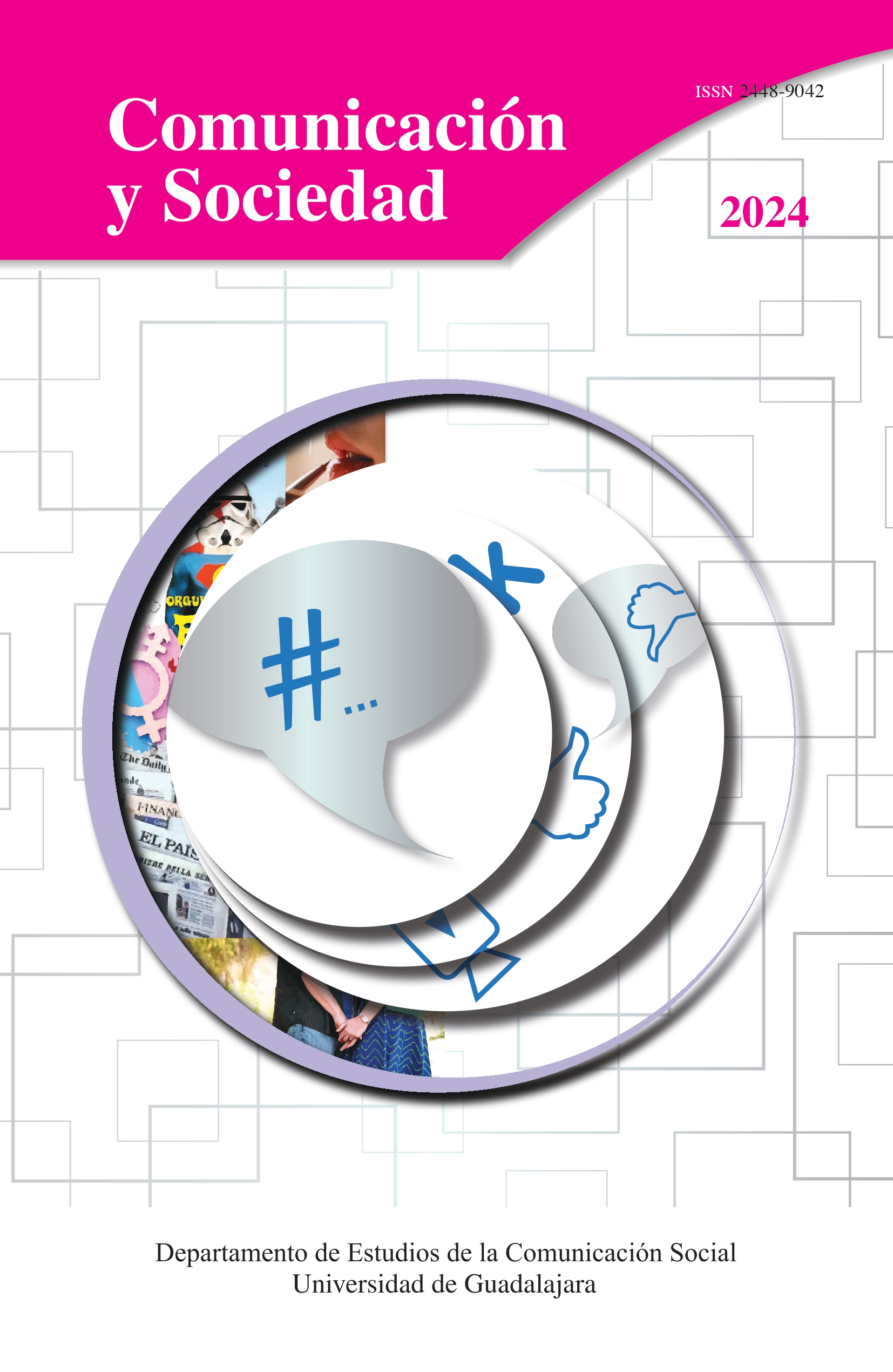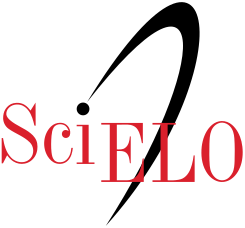Expresión de identidades masculinas en Facebook y TikTok: El caso de De Machos a Hombres y Voices of Brotherhood
DOI:
https://doi.org/10.32870/cys.v2024.8627Palabras clave:
Facebook, Identidad, Masculinidades, Medios sociodigitales, TikTokResumen
El objetivo central del presente trabajo es identificar, a través de un análisis de contenido, la manera en que se expresan rasgos de identidad masculina en las publicaciones de dos perfiles mexicanos en Facebook y en TikTok. Los principales resultados muestran que en el caso de las masculinidades positivas, esto ocurre principalmente a partir de manifestaciones sobre el autocuidado físico y mental y la paternidad participativa. En las conclusiones destaca que existe una necesidad de proponer nuevas escalas de medición de las masculinidades, que se ajusten a las condiciones culturales cambiantes.Descargas
Citas
Anderson, E. (2009). Inclusive Masculinity: The Changing Nature of Masculinities. Routledge.
Anderson, P. (2012). Measuring masculinity in an Afro-Caribbean context. Social and Economic Studies, 61(1), 49-93. https://www.jstor.org/stable/41803739
Arciniega, G. M., Anderson, T. C., Tovar-Blank, Z. G. & Tracey, T. J. (2008). Toward a fuller conception of Machismo: Development of a traditional Machismo and Caballerismo Scale. Journal of Counseling Psychology, 55(1), 19. https://doi.org/10.1037/0022-0167.55.1.19
Barker, G. (2000). Gender equitable boys in a gender inequitable world: Reflections from qualitative research and program development with young men in Rio de Janeiro, Brazil. Sexual and Relationship Therapy, 15(3), 263-82. https://doi.org/10.1080/14681990050109854
Bascán, A. (2007). Algunas consideraciones críticas sobre la aplicación de la metodología de género al estudio de las masculinidades. Revista Venezolana de Estudios de la Mujer, 12(28), 143-158.
Beyer, J. (2022). Knitting masculinities: How men are challenging masculinity and needlework in a post-pandemic age. Fashion, Style & Popular Culture, 10. https://doi.org/10.1386/fspc_00121_1
Boscán, A. S. (2006). Propuestas críticas para una concepción no tradicional de la masculinidad. Opción, 22(51), 26-49.
Boscán, A. S. (2008). Las nuevas masculinidades positivas. Utopía y Praxis Latinoamericana, 13(41), 93-106. https://philpapers.org/rec/LEALNM
Briseño, M. L. (2011). La construcción de la sexualidad y el género en estudiantes de la Escuela Normal Bilingüe e Intercultural de Oaxaca (enbio) [Tesis de Doctorado]. Universidad Nacional Autónoma de México. http://132.248.9.195/ptd2012/enero/0676160/0676160_A1.pdf
Butler, J. (2011). Gender trouble: Feminism and the subversion of identity. Routledge.
Carabí, À. (2000). Construyendo nuevas masculinidades: una introducción. En M. Segarra & Á. Carabí (Eds.), Nuevas masculinidades (pp. 15-28). Icaria.
Chu, J. Y., Porche, M. V. & Tolman, D. L. (2005). The adolescent masculinity ideology in relationships scale: Development and validation of a new measure for boys. Men and Masculinities, 8(1), 93-115. https://doi.org/10.1177/1097184X03257453
Connell, R. W. (1987). Gender and Power. Society, the Person and Sexual Politics. Polity Press, Blackwell.
Connell, R.W. (1995). Masculinities. University of California Press.
Cruzalegui, G. F. (2021). Masculinidad y violencia de género en universitarios de la región de Lima [Tesis de Licenciatura]. Universidad César Vallejo. https://hdl.handle.net/20.500.12692/90015
De Dauw, E. & Connell, D. J. (Eds.). (2020). Toxic Masculinity: Mapping the Monstrous in Our Heroes. University Press of Mississippi.
Doss, B. D. & Hopkins, J. R. (1998). The multicultural masculinity ideology scale: Validation from three cultural perspectives. Sex Roles, 38(9), 719-741. https://doi.org/10.1023/A:1018816929544
Dyer, S. (2018). Masculinities, Wallpaper, and Crafting Domestic Space within the University, 1795–1914. Nineteenth Century Gender Studies, 14.2. https://uhra.herts.ac.uk/bitstream/handle/2299/22514/dyer.pdf
Elliott, K. (2016). Caring masculinities: Theorizing an emerging concept. Men and Masculinities, 19(3), 240-259. https://doi.org/10.1177/1097184X15576203
Espinar-Ruiz, E. & Ocampo, I. (2017). La representación de masculinidades en las páginas web de citas. Un análisis cualitativo. Prisma, 18, 561-570. http://revistaprismasocial.es/article/view/1422
Flood, M., Gardiner, J. K., Pease, B. & Pringle, K. (2007). International Encyclopedia of Men and Masculinities. Routledge.
Foster, J. & Baker, J. (2022). Muscles, makeup, and femboys: Analyzing TikTok’s “radical” masculinities. Social Media + Society, 8(3). https://doi.org/10.1177/20563051221126040
Fraguas, R. (2000). Por una masculinidad positiva. Razón y Fe, 242(1222-1221), 99-104. https://revistas.comillas.edu/index.php/razonyfe/article/view/19222
Fuller, N. (2018). Difícil ser hombre: Nuevas masculinidades latinoamericanas. Fondo Editorial de la pucp.
García, L. F. (2015). Nuevas masculinidades: discursos y prácticas de resistencia al patriarcado [Tesis de Maestría]. flacso Ecuador.
García-Gómez, A. (2020). Discursive representation of masculinity and femininity in Tinder and Grindr: Hegemonic masculinity, feminine devaluation and femmephobia. Discourse & Society, 31(4), 390-410. https://doi.org/10.1177/0957926520903523
Godfrey, S. (2021). Masculinity in British Cinema, 1990-2010. Edinburgh University Press.
Gore, A. (2001). Making student men at the University of Zimbabwe: politics, masculinity and democracy. En R. B. Gaidzanwa (Ed.), Speaking for ourself: masculinities and femininities amongst students at the University of Zimbabwe (pp. 29-48). UZ Publications.
Gough, B. & Novikova, I. (2020). Mental health, men and culture: how do sociocultural constructions of masculinities relate to men’s mental health help-seeking behaviour in the who European Region? World Health Organization.
Gutmann, M. C. (2000). Ser hombre de verdad en la ciudad de México: ni macho ni mandilón. El Colegio de México.
Gutmann, M. C. & Viveros, M. (2005). Masculinities in Latin America. En M. S. Kimmel, J. Hearn & R. W. Connell (Eds.), Handbook of studies on men and masculinites (pp. 114-128). sage.
Harrington, C. (2021). What is “toxic masculinity” and why does it matter? Men and Masculinities, 24(2), 345-352. https://doi.org/10.1177/1097184X20943254
Haywood, C. & Mac an Ghaill, M. (2012). ‘What's next for masculinity?’ Reflexive directions for theory and research on masculinity and education. Gender and Education, 24(6), 577-592. https://doi.org/10.1080/09540253.2012.685701
Hunt, P. (1986). What Would Daddy Have Done? Overt and Covert Constructions of Masculinity in Twentieth Century Children's Literature. Kunapipi, 8(1). https://ro.uow.edu.au/kunapipi/vol8/iss1/22/
Hytti, U., Karhunen, P. & Radu-Lefebvre, M. (2023). Entrepreneurial Masculinity: A Fatherhood Perspective. Entrepreneurship Theory and Practice, 1-28. https://doi.org/10.1177/10422587231155863
Janey, B. A., Kim, T., Jampolskaja, T., Khuda, A., Larionov, A., Maksimenko, A., Sharapov, D & Shipilova, A. (2013). Development of the Russian Male Norms Inventory. Psychology of Men & Masculinity, 14(2), 138. https://doi.org/10.1037/a0028159
Kiselica, M. S. & Englar-Carlson, M. (2010). Identifying, affirming, and building upon male strengths: The positive psychology/ positive masculinity model of psychotherapy with boys and men. Psychotherapy. Theory, Research, Practice, Training, 47(3), 276-287. https://doi.org/10.1037/a0021159
Kimmel, M. S. (1998). From ‘Conscience and Common Sense’ to ‘Feminism for Men: Profeminist Men’s Rhetorics of Support for Women’s Equality. En S. P. Schacht & D. W. Ewing (Eds.), Feminism and Men: Reconstructing Gender Relations (pp. 21–42). New York University Press.
Kimmel, M. S. (2010). Misframing men: The politics of contemporary masculinities. Rutgers University Press.
Krippendorff, K. (1990). Metodología de análisis de contenido. Teoría y práctica. Paidós.
Lackey, R. (2021). Men Playing Together: New Masculinities, Sport, and Contemporary Fiction. En L. R. Cooper (Ed.), The Routledge Companion to Masculinity in American Literature and Culture (pp. 220-236). Routledge.
Lagarde, M. (2005). Los cautiverios de las mujeres. Madresposas, monjas, putas, presas y locas. unam.
Lerner, G. (1986). La Creación del Patriarcado. Crítica.
Luyt, R. (2005). The male attitude norms inventory-II: A measure of masculinity ideology in South Africa. Men and Masculinities, 8(2), 208-229. https://doi.org/10.1177/1097184X04264631
MacInnes, J. (1994). Men in the Public Eye. Sociology, 28(1), 342-344.
Malti-Douglas, F. (2007). Encyclopedia of Sex and Gender. MacMillan.
Marshall, K., Chamberlain, K. & Hodgetts, D. (2020). Male bodybuilders on Instagram: Negotiating inclusive masculinities through hegemonic masculine bodies. Journal of Gender Studies, 29(5), 570-589. https://doi.org/10.1080/09589236.2020.1722620
Martín, A. (2022). Not Into Bad Guys Anyways: Scott McCall, or Positive Representations of Masculine Identities in US Supernatural Teen Drama [Tesis de pregrado]. Universitat de les Illes Balears. https://dspace.uib.es/xmlui/handle/11201/161283
Martínez-Valerio, L. (2023). Mensajes misóginos en los perfiles de TikTok de la prensa española: estudio y percepción por parte de los jóvenes. Ámbitos: Revista Internacional de Comunicación, 59, 110-127. https://doi.org/10.12795/Ambitos.2023.i59.08
McGeeney, E. & Harvey, L. (2015). Cisgender. Living in the Gender Assigned at Birth. En C. Richards & M. G. Barker (Eds.), The Palgrave Handbook of Psychology of Sexuality and Gender (pp. 149-165). Palgrave.
McLean, R. & Schubert, R. (1995). Queers and the Internet. Media International Australia, 78(1), 48-52. https://doi.org/10.1177/1329878X9507800108
Messerschmidt, J. W & Messner, M. A. (2018). Hegemonic, nonhegemonic and "new" masculinities. En J. W. Messerschmidt, P. Y. Martin, M. A. Messner & R. Connell (Eds.), Gender reckonings. New Social Theory and Research (pp. 35-56). New York University Press.
Mirandé, A. (2018). Hombres y machos: Masculinity and Latino culture. Routledge.
Monaghan, L. F. (2005). Big handsome men, bears and others: Virtual constructions of ‘fat male embodiment’. Body & Society, 11(2), 81-111. https://doi.org/10.1177/1357034X05052463
Morrell, R. (1998) The new man? Agenda: Empowering women for gender equity, 14(37), 7-12. https://www.tandfonline.com/doi/abs/10.1080/10130950.1998.9675683
Mustonen, V. (2020). Men and masculinities in Nordic cinema and its American remakes: A comparative analysis [Tesis de maestría]. University of Jyväskylä. https://jyx.jyu.fi/handle/123456789/71632
Nagoshi, J. L. & Nagoshi, C. T. (2013). Gender and sexual identity: Transcending feminist and queer theory. Springer.
Ocampo, I. G. (2015). Un acercamiento a las identidades masculinas desde las online dating [Tesis de licenciatura]. Universidad de Alicante. http://hdl.handle.net/10045/47991
Ojeda, A., Melby, L., Sánchez, V. & Rodarte de Lara, M. (2007). Correlación entre rasgos de masculinidad-feminidad y satisfacción marital en migrantes mexicanos. Migración y Desarrollo, 8, 48-65.
Pascoe, C. J. & Diefendorf, S. (2019). No homo: Gendered dimensions of homophobic epithets online. Sex roles, 80(3-4), 123-136. https://doi.org/10.1007/s11199-018-0926-4
Paulson, S. & Boose, M. (2019). Masculinities and environment. cabi Reviews, 14(030), 1-12. https://doi.org/10.1079/PAVSNNR201914030
Pedraza, C. (2019). Cibermisoginia en las redes sociodigitales: claves para el análisis desde la masculinidad. Cuestiones de género: de la igualdad y la diferencia, 14, 51-66. https://doi.org/10.18002/cg.v0i14.5814
Pérez, G. (2021). Identidad y virtualidad. Aproximaciones desde la Comunicación. Tintable.
Pulerwitz, J. & Barker, G. (2008). Measuring attitudes toward gender norms among young men in Brazil: development and psychometric evaluation of the gem scale. Men and Masculinities, 10(3), 322-338. https://doi.org/10.1177/1097184X06298778
Ray, C. (1998). Let’s hear it for the boys! Health Education, 98(1), 8-14.
Rivera, A. & Scholar, J. (2020). Traditional masculinity: a review of toxicity rooted in social norms and gender socialization. Advances in Nursing Science, 43(1), E1-E10. https://doi.org/10.1097/ANS.0000000000000284
Rojas, O. F. & Morales, A. (2020). Machismo. En B. J. Carducci, C. S. Nave, J. S. Mio & R. E. Riggio (Eds.), The Wiley Encyclopedia of Personality and Individual Differences: Clinical, Applied, and Cross‐Cultural Research (pp. 243-246). Wiley. https://doi.org/10.1002/9781119547181.ch305
Salvati, M., Passarelli, M., Chiorri, C., Baiocco, R. & Giacomantonio, M. (2021). Masculinity threat and implicit associations with feminine gay men: Sexual orientation, sexual stigma, and traditional masculinity. Psychology of Men & Masculinities, 22(4), 649. https://psycnet.apa.org/doi/10.1037/men0000338
Salam, R. (2021). Men will be Men?: Masculinities on display in the Facebook communication practices of Pakistani men. Norma, 16(1), 38-56. https://doi.org/10.1080/18902138.2021.1875640
Sartre, J. P. (2002). El ser y la nada. Ensayo de ontología fenomenológica. Iberoamericana.
Scheibling, C. (2020). “Real heroes care”: How dad bloggers are reconstructing fatherhood and masculinities. Men and Masculinities, 23(1), 3-19. https://doi.org/10.1177/1097184X18816506
Segal, E. S. (2004). Cultural Constructions of Gender. En C. R. Ember & M. Ember, (Eds.), Encyclopedia of Sex and Gender Men and Women in the World's Cultures (pp. 3-23). Kluwer Academic, Plenum Publishers.
Segrest, S. L., Romero, E. J. & Domke‐Damonte, D. J. (2003). Exploring the role of machismo in gender discrimination: A comparison of Mexico and the US. Equal Opportunities International, 22(1), 13-31. https://doi.org/10.1108/02610150310787298
Statista. (2022). El meteórico ascenso de TikTok. https://es.statista.com/grafico/28454/numero-de-usuarios-activos-de-redes-sociales-seleccionadas-a-nivel-mundial/
Strier, R. & Perez‐Vaisvidovsky, N. (2021). Intersectionality and fatherhood: theorizing non‐hegemonic fatherhoods. Journal of Family Theory & Review, 13(3), 334-346. https://doi.org/10.1111/jftr.12412
Trott, V. A. (2022). ‘Gillette: The best a beta can get’: Networking hegemonic masculinity in the digital sphere. New Media & Society, 24(6), 1417-1434. https://doi.org/10.1177/1461444820978293
Underwood, M. & Olson, R. (2019). ‘Manly tears exploded from my eyes, lets feel together brahs’: Emotion and masculinity within an online body building community. Journal of Sociology, 55(1), 90-107. https://doi.org/10.1177/1440783318766610
Vásquez, M. A. (2020). Plan de comunicación digital para el proyecto: campaña educomunicativa multimedia sobre la construcción social de masculinidades para la erradicación de la violencia y discriminación de género [Tesis de Licenciatura]. Universidad Politécnica Salesiana Ecuador. http://dspace.ups.edu.ec/handle/123456789/17652
Venäläinen, S. & Virkki, T. (2019). Struggles for moral value and the reproduction of gendered and racialised hierarchies in online discussions of violence. The Sociological Review, 67(6), 1367-1382. https://doi.org/10.1177/0038026119866635
Versiani, J. C. (2022). “The claws of feminism”: anti-feminist hate speech on Facebook and the sense of controlled urgency. Intercom: Revista Brasileira de Ciências da Comunicação, 45. https://doi.org/10.1590/1809-58442022119en
White, M. (2019). Producing masculinity: The internet, gender, and sexuality. Routledge.
Wilson, M. J. (2022). Cultivating positive masculinity is mental health promotion for boys and men. Health Promotion International, 37(4), 1-2. https://doi.org/10.1093/heapro/daac121
Wilson, M., Gwyther, K., Swann, R., Casey, K., Featherston, R., Oliffe, J. L., Matt Englar-Carlson, M. & Rice, S. M. (2022). Operationalizing positive masculinity: a theoretical synthesis and school-based framework to engage boys and young men. Health Promotion International, 37(1), https://doi.org/10.1093/heapro/daab031
Wong, Y. J., Horn, A. J., Gomory, A. M. & Ramos, E. (2013). Measure of Men’s Perceived Inexpressiveness Norms (M2PIN): Scale development and psychometric properties. Psychology of Men & Masculinity, 14(3), 288. https://doi.org/10.1037/a0029244
Descargas
Publicado
Cómo citar
Número
Sección
Licencia

Esta obra está bajo una licencia internacional Creative Commons Atribución-NoComercial 4.0.
Los autores/as que publiquen en esta revista aceptan las siguientes condiciones:
De acuerdo con la legislación de derechos de autor, los autores conservan los derechos de autoría y otorgan a Comunicación y Sociedad el derecho de primera comunicación pública de la obra. Comunicación y Sociedad no realiza cargos a los autores por enviar y procesar artículos para su publicación.
Los autores/as pueden realizar otros acuerdos contractuales independientes y adicionales para la distribución no exclusiva de la versión del artículo publicado en Comunicación y Sociedad (por ejemplo incluirlo en un repositorio institucional o publicarlo en un libro) siempre que indiquen claramente que el trabajo se publicó por primera vez en Comunicación y Sociedad.











